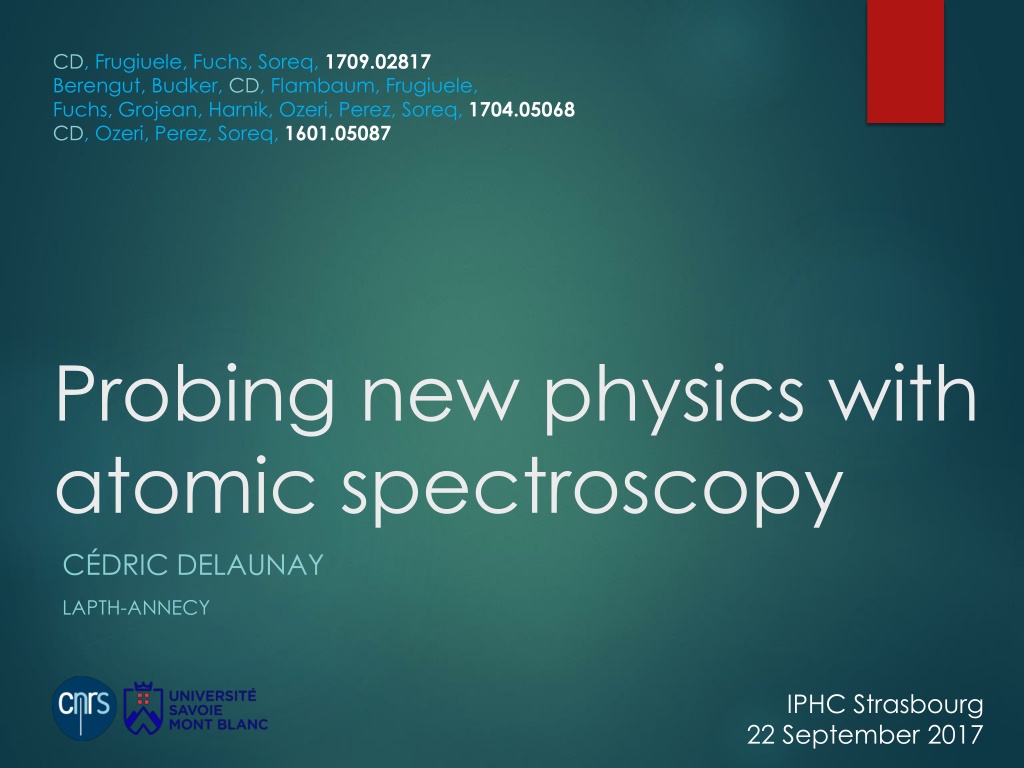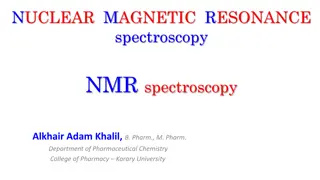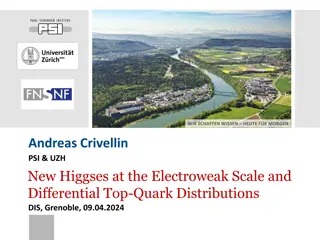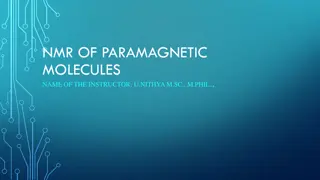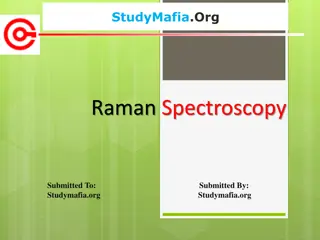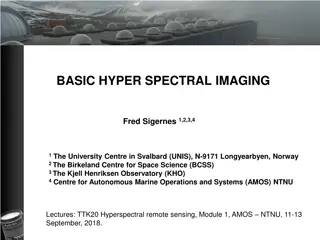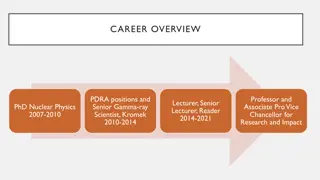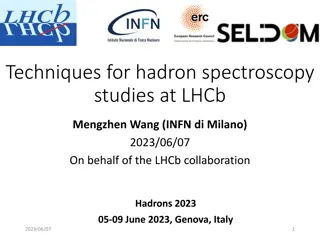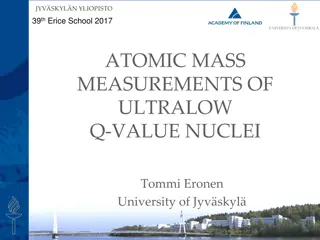Exploring Physics Beyond the Standard Model through Atomic Spectroscopy
Unlocking the mysteries of physics beyond the Standard Model using atomic spectroscopy techniques. Delving into the shortcomings of the Standard Model and the quest for new physics through precision measurements of atomic forces and isotope shifts in heavy atoms. Highlighting the importance of the precision frontier in probing new physics phenomena.
Uploaded on Sep 06, 2024 | 0 Views
Download Presentation

Please find below an Image/Link to download the presentation.
The content on the website is provided AS IS for your information and personal use only. It may not be sold, licensed, or shared on other websites without obtaining consent from the author. Download presentation by click this link. If you encounter any issues during the download, it is possible that the publisher has removed the file from their server.
E N D
Presentation Transcript
CD, Frugiuele, Fuchs, Soreq, 1709.02817 Berengut, Budker, CD, Flambaum, Frugiuele, Fuchs, Grojean, Harnik, Ozeri, Perez, Soreq, 1704.05068 CD, Ozeri, Perez, Soreq, 1601.05087 Probing new physics with atomic spectroscopy C DRIC DELAUNAY LAPTH-ANNECY IPHC Strasbourg 22 September 2017
Outline Motivations BSM, precision frontier Atomic forces in/beyond the SM Probes in atoms with few electrons helium, hydrogen/deuterium, positronium Isotope-shift probes in heavy atoms King linearity Interpretation in known models dark photon, B-L gauge boson Conclusion
Motivations PHYSICS BEYOND THE STANDARD MODEL? IMPORTANCE OF THE PRECISION FRONTIER
The Standard Model The SM is trementous success It describes well* all (non-gravitational) phenomena up to ~1TeV energies! It provides a good parameterization of: electroweak symmetry breaking, close to the Higgs mechanism ( >few TeV) flavor- and CP-violating, close to the CKM picture ( >104-5 TeV) With a 125GeV Higgs boson, the SM is a consistent theory, potentially up to the Planck scale ~1019GeV * modulo few persisting anomalies: muon g-2, b s
The Standard Model Yet, the Standard Model is an incomplete theory, which has several important shortcomings: No neutrino oscillations No (cold) dark matter candidate Insufficient baryon asymmetry Besides the SM suffers from several theoretical issues: The Higgs mass is unstable under high-scale quantum corrections (naturalness problem) The neutron EDM is not suppressed (strong CP problem) Its flavor parameters are very small and hierarchical (flavor puzzle) Any of the above requires physics beyond the SM None of the above unquestionably* points to a given scale: ? * naturalness favors ~TeV, yet with known exceptions (relaxion) and increasing pressure from the LHC
New-physics searches Energy frontier discover new massive particles with few events at high energies (take close-up pictures) BSM Physics Intensity frontier find deviations in low-energy observables with large statistics (increase luminosity/contrast) Precision frontier find deviations in low-energy observables measured with high precision (increase sharpness)
Precision frontier in atoms With the advent of modern optics and cooling technologies the atom has become a golden field for physics at very high precision. Precision atomic physics offered ultra sensitive probes of exotic phenomena beyond the SM which breaks QED symmetries: Parity-violation (eg. Cesium: >few TeV) CP violation (eg. Tallium: >few PeV)
Precision atomic spectroscopy The frequency comb technique opened the way towards precision measurements of atomic transition frequencies in the optical range (Nobel in Physics 2005) Thanks to their higher stability, narrow optical transitions are now the most accurately measured eg. Octupole transition (E3) in Ytterbium ion Godun+ PRL 113, 210801 (2014) Huntermann+ PRL 113, 210802 (2014) accuracy Significant improvement is expected: eg. uncertainty of E3 in Yb+ is reaching Huntermann+ PRL 116, 063001 (2016)
Precision atomic spectroscopy In terms of length, this would correspond to measure the distance to the nearest stars (~10 ly) with meter-precision! In principle, these measurements could thus be sensitive to new forces weaker than QED by 18 orders of magnitude! This level of precision makes atomic spectroscopy a sensational probe of BSM physics complementary to the energy/intensity frontiers.
Atomic forces in/beyond the Standard Model GENERIC SPIN-INDEPENDENT FORCES THE HIGGS FORCE
Atomic potentials Consider a new boson with parity-even couplings to electrons and nucleons: and At low energies it gives rise to a short-range, spin- independent force between atomic nuclei and their bound electrons described by: mediator mass mediator spin nuclear coupling electronic coupling
Atomic potentials Inevitably, if the new boson couples to electrons, there is also a similar force acting on pairs of bound electrons: is the distance between two electrons Both electron-nucleus and electron-electron new interactions above will correct the transition frequencies whose values are approximately set by the Coulomb potential:
Energy level shifts Consider a transition i between two energy levels a,b ( ) in a given atom b Relaxing from b to a, the atom emits a photon of frequency ( ): a Energy In the presence of the new force, energy levels are shifted in a state- dependent way, so that:
Energy level shifts Taking can be described in QM by (time-independent) perturbation theory. , the energy-level shift due to Schematically: first-order energy correction electron wavefunction in the absence of new physics (ie. from only)
Energy level shifts In an atom with electrons, this yields : where X,Y are overlap integrals of the Yukawa potentials with the electron wavefunctions For hydrogen and helium we use known non- relativistic (hydrogenoid or Hylleraas) wave functions Hylleraas (1928) In heavy atoms, we simulate the atomic structure using relativistic many-body perturbation theory Berengut+ PRA 73 (2006)
Typical atomic bound X,Y integrals are difficult to guestimate but they admit simple limits: coupling For the Yukawa potential is Coulomb-like ( ) leading to constant bound For potential is point-like ( bound weakens like (or faster if cancelations) the ) and the mass In between, new physics contributions for the two states are comparable in size and may cancel
The atomic Higgs force The exchange of the Higgs boson between a nucleus and its bound electron gives rise to force of the type above with and Shifman+ PLB 78, 443 (1978) In the SM, the couplings of the Higgs boson are proportional to the fermion mass : universal proportionality factor being the VEV of the Higgs field with a As a result, the (SM) Higgs force is very suppressed: CD+ arXiv:1601.05087
Higgs couplings from data Yet, little is known experimentally about how the Higgs boson couples to fermions, especially the electron and the up and down quarks. Model independent bounds from LHC give: Perez+ PRD 93, 013001 (2015) Altmannshofer+ JHEP 1505, 125 (2015) Hence, the Higgs force could be stronger than the SM prediction by ~6 orders of magnitude!down up electron
Frenquency shifts from the Higgs force Since the Higgs mass is much larger than any other scale in the atom, the Higgs force is well described by a point-like interaction: As a result, the energy level shifts are controlled by the electron density near the nucleus: electron density at the origin (in units of ) CD+ arXiv:1601.05087
Frenquency shifts from the Higgs force For states with the nucleus is very suppressed due to angular momentum conservation (up to spin-orbit coupling). (P,D, -waves), the density at For states (S-waves), the density at the nucleus can be extracted from hyperfine splitting (HFS) measurements. Moreover, for atoms with a single valence electron, it is well approximated by the formula: Budker+ Atomic Physics ionization # linear in the nuclear charge due to screening of core electrons quantum defect Sobelman Atomic Spectra and Radiative Transitions principal quantum #
Frenquency shifts from the Higgs force Consider optical transitions in Ca, Sr and Yb ions, which involve a ground-state: Assume saturated LHC bound on the Higgs couplings: Then, the frequency shift due to the Higgs force in these transitions could reach: Such transitions are typically measured with Hz accuracy. Hence, these atomic observables are more sensitive than the LHC by a factor of ~1000 CD+ arXiv:1601.05087
Probing BSM with atomic spectroscopy As we saw experimental sensitivity is very good But to make up probes of these measurements one needs either : Very precise theoretical (QED) calculations available only for atoms with few (1,2) electrons eg. Helium frequencies knwon to accuracy surpassing experimental To construct observables largely insensitive to theory uncertainties King linearity of isotope shifts
Probing BSM in atoms with few electrons HYDROGEN, HELIUM, POSITRONIUM ISOTOPE SHIFTS
Transition frequencies Theory The theory prediction for a transition i in a given atom A is: Leading finite nuclear size contribution: is the rms charge radius squared, is a (calculable) electronic constant dominant contribution calculated in the point-nucleus limit to high-order in (incl. nuclear spin and polarizability effects) possible new physics contribution Higher-order effects in the nuclear finite size are not resolvable by current experimental precision.
Nuclear charge radius While accuracy, the theory prediction is generally limited by a poorer knowledge of the nuclear charge radius. and can be calculated with sufficient The charge radius is determined by independent measurements in: electron scattering off of nuclei (~1%) muonic spectroscopy (<0.1%) The proton charge radius is still a big puzzle: muonic hydrogen spectroscopy disagrees with electronic measurements (CODATA) by ~7 Pohl+ Nature 466, 213 (2010) Antognini+ Science 353, 669 (2013)
Precisely measured transitions in Helium Pachucki+ arXiv:1704.06920 Transitions between singly- excited states are very well measured: orbital momentum total spin S=0,1 nL Energy 1s Total angular momentum J=L+S orbital # of excited electron Helium 4 data agrees with theory up to ~few kHz
Bound on electro-philic forces Consider new physics couples only to electrons Bounds from helium spectroscopy are roughly comparable to positronium and electron g-2 below 1keV CD+ arXiv:1709.02817
Helium Isotope shifts Frequency shifts between helium 3,4 isotopes are measured and predicted from theory with 2 orders of magnitude higher accuracy (systematics cancel out) This gives strong bounds on electron-neutron interactions A factor ~100 improvement is expected with He charge radii extracted from muonic spectroscopy Antognini+ Can. J. Phys. 89, 47 (2011) CD+ arXiv:1709.02817
HD isotope shifts Despite the proton size puzzle, electronic and muonic measurements of the difference of hydrogen and deuterium charge radii are consistent within uncertainties Pohl+ Science 353, 669 (2016) Strongest bounds from 1S-2S, 2S-12D transition Lamb shift corrections: Weitz+ PRA 52, 2664 (1995) CD+ arXiv:1709.02817
Probing BSM with clock transitions in heavy atoms ISOTOPE SHIFTS KING LINEARITY
Optical clock transitions Narrow optical ( clock ) transitions in heavy elements are measured with better (~1Hz) accuracy Yet, they have too many electrons which greatly limits the precision of the theory calculation. Many-body simulations predict the transition frequencies with ~1% accuracy at best. Direct comparison between theory and experiment is therefore not possible
Basic idea For point-like ( two (zero-spin) isotopes A and A have the exact same spectrum within QED: ) and static ( ) nuclei, On the other hand, since contribution is only mildly suppressed by the new physics New physics leads to isotope shift:
Isotope shifts from nuclear physics In the real world, nuclei have isotope-dependent finite mass and finite (charge) radius: mass shift (MS) field shift (FS) Given their nuclear nature IS are small, typically GHz, But they are also hardly predictable from theory. While masses are measured with ~10-10uncertainty, charge radii are determined from scattering experiment with insufficient (~0.1%) precision.
King linearity We need an observable sensitive to new physics and only limited by the precision of IS measurements Such an observable was discovered long ago: King linearity King J. Opt. Soc. Am. 53, 638 (1963) The idea is to use IS measurements in another transition with the same isotopes to get rid of Provided relation between IS of the two transitions follows is valid, a linear
King linearity This linearity is independent of the value of the F,K constants and the charge radius differences It is the mere result of the factorization of electronic and nuclear parameters: independent of A,A Establising linearity is thus only limited by the precision of IS an nuclear mass measurements
King linearity violation from new physics In the presence of new physics forces, the theory prediction for IS becomes: New physics then implies King linearity violation: Vector notation:
King linearity violation from new physics Caveat new physics sensitivity is suppressed in either of the following cases: eg. for short-range forces with as in this case or constant of AA only for very exotic forces with
Bounding new physics In order to test linearity 2 transitions and 4 isotopes (at least) are needed. If data is consistent with linearity within experimental uncertainty, a bound can be put on new physics coupling vs. mass: area of the triangle formed by the 3 points on the King plot the only theoretical inputs (depend on )
King Linearity in Ca+data 4p3/2 4p1/2 3d5/2 3d3/2 4s 1s Gebert+ PRL 115 (2015) core electrons closed shells A=40 A =42,44,48 precision ~ 100kHz
Ca+bound Combined bound from neutron scattering off of Pb nuclei and electron g-2 Astrophysical bound from energy losses galaxy cluster Combined bound from supernova cooling and electron g-2 Searches for gravity-like forces with torque balance Berengut+ arXiv:1704.05068
Clock transitions The Ca+bound is based on broad dipole-allowed transitions (S P, D P) with ~10MHz width, thus limiting the precision to ~100kHz IS measurements in very narrow transitions with sub-Hz width could improve sensitivity by 5 orders of magnitude There is a unique candidate with 2 clock transitions and 4+ stable (spin-zero) isotopes: Yb+ Also, several elements have a clock transition for the ion and the neutral atom: Ca, Sr, Ba, Yb
Sensitivity estimates Assume linearity is established within a precision Then, factorization holds within uncertainties: And a best-case estimate of the resulting bound is: suppression factor for short-range forces calculated from MBPT Berengut+ PRA 73 (2006) alignment with MS
Projections Assume state-of-the-art accuracy of 1Hz in all IS measurements Assume linearity is established to that level. Recent many-body estimates show that this is realistic for Sr+ Flambaum+ arXiv:1709.00600 Berengut+ arXiv:1704.05068
Interpretation in known BSM models HIGGS AND HIGGS-LIKE FORCES, DARK PHOTON, U(1)B-LZ
Dark photon Consider a new massive U(1) gauge boson A kinetically mixed with the photon. Its couplings are rescaled from QED couplings by a universal mixing angle , thus , Helium (combined with g-2) is the best indirect bound from laboratory experiments above 100keV CD+ arXiv:1709.02817
B-L gauge boson Consider a new massive U(1) gauge boson Z coupled to B-L current, Projected IS sensitivity in Sr+ and Yb+ will extend the reach of laboratory experiments in the mass range [300eV,1MeV] Frugiuele+ PRD 96, 015011 (2017)
Conclusions The precision frontier in atoms offer sensitive probes to new physics complementary to high- energy colliders Light bosons below the GeV can be efficiently probed through precision spectroscopic measurements in helium, positronium, hydrogen/deuterium In heavy atoms, despite the lack of accurate theoretical calculations, isotope shift in precisely measured/measurable optical clock transition could provide very strong bounds from King linearity violation
